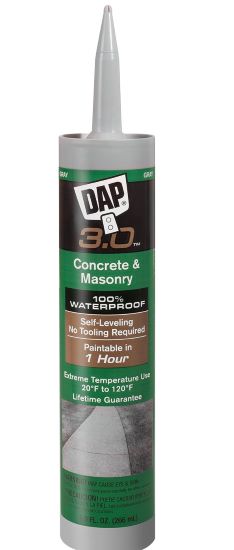How To Resurface And Repair
Your Concrete Pool Deck
The best way to resurface and repair your concrete pool deck is to use a concrete resurfacing product like Sakrete Flo-Coat, NewCrete by Rapid Set, or Ardex CD.
The basic steps for resurfacing a pool patio are:
- Grind or Pressure Wash the surface to clean it
- Repair any cracks, chipped areas, and spalling
- Smooth patched areas by using a rubbing stone or grinding
- Rinse or vacuum the concrete to remove dust
- Mask off any abutting areas you want to keep clean
- Mix and apply resurfacing material
- Drag broom across the surface to give it texture
- Apply concrete sealer to protect it
VIDEO TUTORIAL BELOW!!
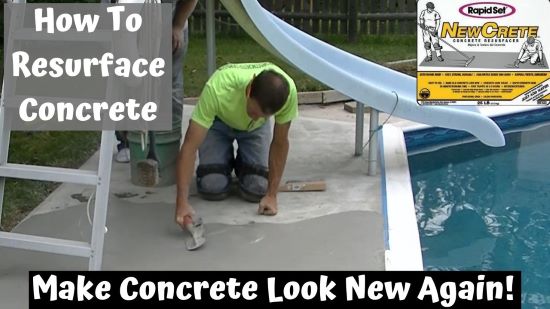 That's me, repairing and resurfacing a pool patio
That's me, repairing and resurfacing a pool patioThe tools you'll need are:
- Pressure Washer
- Hand Grinder (optional)
- Vacuum (optional)
- Leaf blower (optional)
- Steel trowel or squeegee
- Drill and mixing paddle
- Broom
Concrete Resurfacing products to use:
- Sakrete Flo-Coat
- NewCrete by Rapid Set
- Ardex CD - Usually can order from local concrete supply store.
STEP 1: PREPARE THE SURFACE
So, you've made the decision to resurface your concrete. The first thing you need to do is clean the surface.
You have to remove all the loose, damaged concrete if there is any.
And you have to remove any dirt, debris, mold, and mildew.
The two ways I do that are by either lightly grinding the concrete or by pressure washing the concrete.
 Lightly grinding
Lightly grinding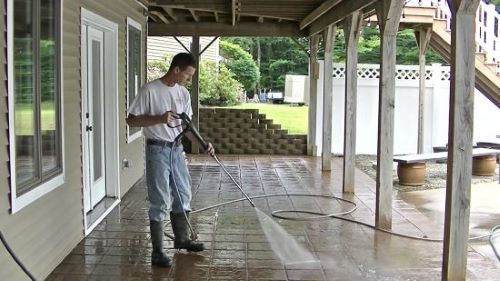 Pressure wash to clean
Pressure wash to cleanIf you grind the concrete use a face mask and hook up a vacuum to the grinder to reduce any dust.
Pressure washing will work just fine for cleaning as long as you don't have any loose and spalling concrete.
Completely clean the concrete afterwards by vacuuming any leftover dust or rinsing off any loose dirt left over by the pressure washer.
If you washed the concrete, let it dry out for 24 hours before proceeding.
STEP 2: REPAIR DAMAGED AREAS
If you have any cracks, chipped areas, broken concrete, or spalled concrete, now is the time to fix your concrete.
If the cracks are hairline, there's nothing you can do about those, just leave them and resurface over them.
If the cracks are 1/16" wide or more, you have to fill them with a repair material like Dap flexible concrete crack sealant.
If the crack is wider than 1/4", I recommend filling some of the crack with dry sand or foam backer rod.
Leave about 1/4 to 3/8 inch of the crack to fill, that'll work good for repairing the cracks.
As soon as the sealant levels out, sprinkle some dry sand on it to give it some texture.
The resurfacing material needs the texture to bond to.
Just keep in mind, whenever repairing cracks in a pool patio, they may still be moving cracks. If the cracks move at all, the resurfacing material may show a hairline crack where the existing crack was.
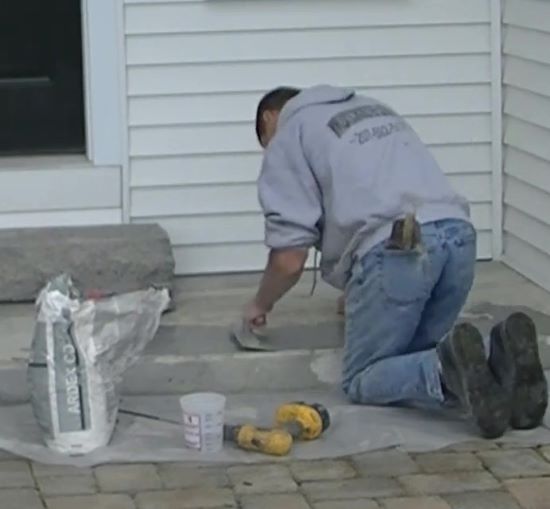
If you have any chipped or spalling areas, you can use the resurfacing material to fix these with.
Just mix up a small batch and fill these areas after you've removed any loose concrete.
Let the patched area completely dry then smooth the area with your grinder or a rubbing stone.
STEP 3: RINSE, VACUUM, OR LEAF BLOWER TO CLEAN
After you've repaired any cracks, chipped, or spalled concrete, you have to clean the concrete again to make sure the resurfacing material bonds to it.
PRO TIP: I use a powerful leaf blower to clean the concrete and keep the concrete dry so I can resurface it the same day.
Again, if you use water to rinse off the concrete, let it dry out again for 24 hours.
If you didn't have any areas to fix, you can skip this step because you've already cleaned your concrete
STEP 4: MASK OFF AREAS
Mask off any areas you don't want to get dirty. Use painters tape to keep the pool coping clean, ladder clean, hand railing, and skimmer all clean.
The resurfacing material will adhere to these things and be very hard to clean off after it drys.
If you have the plastic divider strips in your concrete deck, you'll want to mask off the tops of these also.
PRO TIP: Pull the tape when you are resurfacing, right after you go by or over each object. If you wait till the next day, the tape will pull off hard where any resurfacer gets on it.
STEP 5: MIX AND APPLY RESURFACER
You're now ready to mix and apply the concrete resurfacer to your pool patio.
I've used all three of these concrete resurfacing materials with good luck.
- Sakrete Flo-Coat
- NewCrete by Rapid Set
- Ardex CD - Get this at your local concrete supply store.
They all mix and are applied with either a steel trowel or a squeegee.
Follow the mixing instructions on the bag. Usually you mix 3.5 quarts of water with 1 bag. Mix for 2 minutes until it's lump free and kinda like pancake batter.
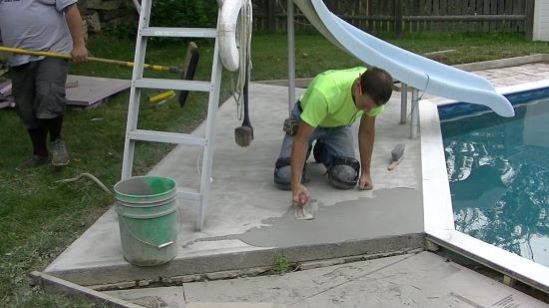 Mix the material to a pancake batter viscosity.
Mix the material to a pancake batter viscosity.STEP 6: BROOM FINISH TEXTURE
As soon as you trowel or squeegee the resurfacer to an area about a couple broom widths wide, drag your broom across the surface to give your pool patio a new texture.
Don't wait to broom it, the material drys fairly quickly. Do a small section and broom it, then do another small section and broom it. It helps to have help like I do in the picture, then you can just keep moving, slowly from one end to the other.
 Have a helper if you can, it's much easier
Have a helper if you can, it's much easierWatch me do it
STEP 7: Protect it with sealer
Apply a concrete sealer like RadonSeal deep penetrating concrete sealer. You can watch me in the video below to learn how to apply it.
